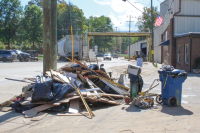Unexpected pleasures from a trip across the state
Sometimes what we expect to happen doesn’t:
On vacation this week, I stopped in Raleigh and viewed the “Rembrandt in America” exhibit currently showing at the N.C. Museum of Art. I enjoyed the exhibit very much indeed. But what honestly carried far greater emotional impact for me was a secondary exhibit by North Carolina artist Beverly McIver.
McIver is an African-American woman born in Greensboro; she lives now in Durham. McIver’s work to date has focused on her mother, Ethel, who died in 2004. And on Beverly McIver’s mentally disabled sister, Renee, who is in her 50s but has the “mental mindset” of a second-grader.
McIver’s paintings are bold. They are raw and honest. Her rendering of her mother in “Mom Died” literally and unexpectedly brought me to tears. Her mother’s mouth is open, a hole in a white, unfilled-in face. Ethel is lying flat in her hospital bed; the perspective is incredibly pain-filled and heartfelt, unmistakably real.
I have cried listening to certain music performances. I have cried while reading particular books. Never have I been forced to leave an art exhibit because of overwhelming emotion and tears. This was a new, welcome if painful, experience, and Beverly McIver’s powerful paintings are an exciting addition to my life. I look forward to seeing what she will produce in the coming years, and have every intention of tracking her work in various galleries. What a tremendous gift this woman has, and the labor she has clearly invested into mastering her craft is sobering but inspiring.
McIver’s work hangs at the state museum through June 24. Rembrandt’s, by the way, can be viewed through Jan. 22.
Related Items
•••
Learning dreams really can come true:
I stayed as a guest in a 15-year-old community in Carrboro, Arcadia Co-housing, which residents tout as “a progressive, intentional community governed by consensus.” Amazingly enough, that proud claim rings true — there are 33 families here, each living in their own individual houses. Residents work together to create an interconnected community. Arcadia consists of 16.5 acres of land, but development is limited to five of those acres. The remainder is kept in woods, a field, a pond, a community garden and meadows.
All households are represented on Arcadia’s board of directors. Business meetings are held monthly, there are work signup parties quarterly, steering committee meetings are scheduled monthly, and other meetings (stonings? banishments? The group’s website doesn’t specify) are held “as needed.”
I stayed in a room located in Arcadia’s common house. The group built this common facility, in part, to provide housing for guests. This keeps residents’ houses smaller and absent of guest rooms that would only experience occasional use. There’s a laundry in the common house so that residents don’t have these appliances in their homes, a multipurpose sitting area, rooms geared toward kid activities, extra storage room and a large kitchen with a dining area. Monthly community meals are scheduled, with volunteers doing the cooking.
I’m a raging liberal by almost any definition you choose. But I admit to harboring a certain skepticism when it comes to intentional housing. I would never have believed it could work, much less for 15 years, and furthermore seem really cool and fun.
My friend Kevin Corbin, who is as far to the right as I am to the left, happened to call while I was visiting in Arcadia. He wanted to chat about a particular article I’d written about the commission board in Macon County, which he chairs. Kevin’s son attends UNC-Chapel Hill’s dental school, an odd choice for the scion of such a proud GOP-oriented family. Kevin assures me that UNC’s dental school is different from regular UNC. It is suitably conservative, he said, even for a Corbin.
Kevin laughed when I told him I was in Carrboro. “You know that even the people who live in Chapel Hill think Carrboro is too liberal. Don’t you?” he asked me, clearly amused but also not speaking in jest.
Maybe indeed Arcadia could exist only in a bastion of liberals, but it’s neat indeed that it does work, regardless of where. We could use more Arcadias in our world.
•••
And, finally, the loveliness of our state:
When it comes time for my occasional trips to the beach, I’ve consistently chosen South Carolina because of its relative nearness to Western North Carolina. This vacation, however, I struck out on Interstate 40 and then to the Outer Banks. What a delight this place has proven.
The ocean here is strikingly rough, churning and chopping in unceasing, un-rhythmic, mesmerizing motion. The shells deposited on beaches bear the branding of this unforgiving ocean — they are rarely whole, usually just bits and pieces. There’s a natural beauty to this region that seems unique from other coastal areas I’ve visited. There’s something about being surrounded by so much water that is stunning, and even a bit overwhelming and frightening.
Damage from last year’s hurricane is clearly visible. Driving north down the coast, you come to a heavily hit, abandoned-appearing vacation or second-home community. Porches of houses were sheared, hanging desolate and broken in the sky; house pilings exposed, in places collapsed. Water was everywhere, in areas where water was not wanted or welcome. The place was a disaster.
The sign on the development was unintentionally prescient of what occurred: “Dare to Dream the Impossible Dream,” it read cheerily, a slogan written to entice potential buyers pre-Hurricane Irene.
It seems to me that building in the Outer Banks is a crapshoot. More hurricanes will come; continued erosion is a given, not a guess. Sort of like building in defiance of a mountain’s grain; at least, that’s what this visitor from WNC couldn’t help but think.
(Quintin Ellison can be reached at This email address is being protected from spambots. You need JavaScript enabled to view it..)









